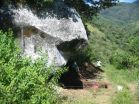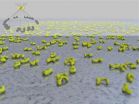(Press-News.org) Archaeologists working at the Smithsonian Tropical Research Institute in Panama have discovered a cluster of 12 unusual stones in the back of a small, prehistoric rock-shelter near the town of Boquete. The cache represents the earliest material evidence of shamanistic practice in lower Central America.
Ruth Dickau, Leverhulme Post-doctoral Fellow at the University of Exeter in England, unearthed the cache of stones in the Casita de Piedra rock-shelter in 2007. A piece of charcoal found directly underneath the cache was radiocarbon dated to 4,800 years ago. A second fragment of charcoal in a level above the cache was dated to 4,000 years ago.
"There was no evidence of a disturbance or pit feature to suggest someone had come along, dug a hole and buried the stones at a later date," Dickau said. "The fact that the stones were found in a tight pile suggests they were probably deposited inside a bag or basket, which subsequently decomposed."
Based on the placement and the unusual composition of the stones in the cache, Richard Cooke, STRI staff scientist, suggested they were used by a shaman or healer. Consulting geologist Stewart Redwood determined that the cache consists of a small dacite stone fashioned into a cylindrical tool; a small flake of white, translucent quartz; a bladed quartz and jarosite aggregate; a quartz crystal aggregate; several pyrite nodules that showed evidence of use; a small, worn and abraded piece of chalcedony; a magnetic andesite flake; a large chalcedony vein stone; and a small magnetic kaolinite stone naturally eroded into an unusual shape, similar to a flower.
"A fascinating aspect of this find is that these are not ordinary stones but are rocks and crystals commonly associated with gold deposits in the Central Cordillera of Panama and Central America," Redwood said. "However, there are no gold artifacts in the rock-shelter, and there's no evidence that the stones were collected in the course of gold prospecting as the age of the cache pre-dates the earliest known gold artifacts from Panama by more than 2,000 years. But the collector of the stones clearly had an eye for unusual stones and crystals with a special significance whose meaning is lost to us."
Indigenous groups who lived near this site include the Ngäbe, Buglé, Bribri, Cabécar and the now-extinct Dorasque peoples. Shamans or healers (curanderos) belonging to these and other present-day First Americans in Central and South America often include special stones among the objects they use for ritual practices. Stones containing crystal structures are linked to transformative experiences in many of their stories.
Anthony Ranere, from Temple University in Philadelphia, first identified and excavated Casita de Piedra in an archaeological survey of western Panama in the early 1970s. He found that the small rock-shelter had been repeatedly occupied over thousands of years and used for a variety of domestic activities such as food processing and cooking, stone-tool manufacture and retouch, and possibly woodworking. Dickau returned to the site to expand excavations from December 2006 to January 2007.
Dickau's group radiocarbon dated charcoal from the base levels of the shelter and discovered it was first occupied more than 9,000 years ago, much earlier than Ranere originally proposed. Her research also showed that the people who would have benefitted from the shaman's knowledge practiced small-scale farming of maize, manioc and arrowroot, and collected palm nuts, tree fruits and wild tubers. They also probably hunted and fished in the nearby hills and streams, but the humid soils in the shelter destroyed any evidence of animal bones. Other Preceramic peoples in Panama who lived in small, dispersed communities across the isthmus by 4,000 years ago commonly practiced these activities.
INFORMATION:
This research project was authorized by Panama's National Institute of Culture and funded by the Smithsonian and the Social Sciences and Humanities Research Council of Canada.
The Smithsonian Tropical Research Institute, headquartered in Panama City, Panama, is a unit of the Smithsonian Institution. The Institute furthers the understanding of tropical nature and its importance to human welfare, trains students to conduct research in the tropics and promotes conservation by increasing public awareness of the beauty and importance of tropical ecosystems. Website: www.stri.si.edu.
Dickau, R., Redwood, S.D., Cooke, R.G. 2012. A 4,000-year-old shaman's stone cache at Casita de Piedra, western Panama. Archaeol Anthropol Sci. doi 10.1007/s12520-012-0112-5 online
4,000-year-old shaman's stones discovered near Boquete, Panama
2013-01-15
ELSE PRESS RELEASES FROM THIS DATE:
NIH scientists identify protective role for antibodies in Ebola vaccine study
2013-01-15
WHAT: Researchers at the National Institutes of Health (NIH) and Oregon Health & Science University (OHSU) have found that an experimental vaccine elicits antibodies that can protect nonhuman primates from Ebola virus infection. Ebola virus causes severe hemorrhagic fever in humans and nonhuman primates, meaning that infection may lead to shock, bleeding and multi-organ failure. According to the World Health Organization, Ebola hemorrhagic fever has a fatality rate of up to 90 percent. There is no licensed treatment or vaccine for Ebola virus infection.
Several research ...
Rice researchers see surprising twist to protein misfolding
2013-01-15
An effort to develop software that unravels the complexities of how proteins fold is paying dividends in new findings on how they misfold, according to researchers at Rice University.
The study published this week in the Proceedings of the National Academy of Sciences by chemist Peter Wolynes and his team at Rice's BioScience Research Collaborative should be of particular interest to those who probe the roots of degenerative diseases associated with the aggregation of amyloid fibers in the body. These include Alzheimer's and Parkinson's diseases and Type 2 diabetes.
The ...
Diet may not impact certain health outcomes in older persons
2013-01-15
UNIVERSITY PARK, Pa. -- Eating diets high in sugar and fat may not affect the health outcomes of older adults ages 75 and up, suggesting that placing people of such advanced age on overly restrictive diets to treat their excess weight or other conditions may have little benefit, according to researchers at Penn State and Geisinger Healthcare System.
"Historically people thought of older persons as tiny and frail," said Gordon Jensen, head of the Department of Nutritional Sciences at Penn State, "but that paradigm has changed for many older persons. Currently, 30 percent ...
Will changes in climate wipe out mammals in Arctic and sub-Arctic areas?
2013-01-15
The climate changes depicted by climatologists up to the year 2080 will benefit most mammals that live in northern Europe's Arctic and sub-Arctic land areas today if they are able to reach their new climatic ranges. This is the conclusion drawn by ecologists at Umeå University in a recently published article in the journal Plos ONE.
The scientists Anouschka Hof, Roland Jansson, and Christer Nilsson of the Department of Ecology and Environmental Science at Umeå University investigated how future climate changes may come to impact mammals in northern Europe's Arctic and ...
Generic HIV treatment strategy could save nearly $1 billion annually but may be less effective
2013-01-15
NEW YORK (Jan. 14, 2013) -- Replacing the combination of brand-name, antiretroviral drugs currently recommended for control of HIV infection with soon-to-be-available generic medications could save the U.S. health care system almost $1 billion a year but may diminish the effectiveness of HIV treatment. A study led by Massachusetts General Hospital (MGH) and Weill Cornell Medical College investigators, appearing in the January 15 Annals of Internal Medicine, examines the potential impact of such a change.
"The switch from branded to generic antiretrovirals would place ...
Scientists discover structure of protein essential for quality control, nerve function
2013-01-15
LA JOLLA, CA – January 14, 2013 – Using an innovative approach, scientists at The Scripps Research Institute (TSRI) have determined the structure of Ltn1, a recently discovered "quality-control" protein that is found in the cells of all plants, fungi and animals.
Ltn1 appears to be essential for keeping cells' protein-making machinery working smoothly. It may also be relevant to human neurodegenerative diseases, for an Ltn1 mutation in mice leads to a motor-neuron disease resembling amyotrophic lateral sclerosis (ALS, also known as Lou Gehrig's disease).
"To better ...
CU-led study shows pine beetle outbreak buffers watersheds from nitrate pollution
2013-01-15
A research team involving several scientists from the University of Colorado Boulder has found an unexpected silver lining in the devastating pine beetle outbreaks ravaging the West: Such events do not harm water quality in adjacent streams as scientists had previously believed.
According to CU-Boulder team member Professor William Lewis, the new study shows that smaller trees and other vegetation that survive pine beetle invasions along waterways increase their uptake of nitrate, a common disturbance-related pollutant. While logging or damaging storms can drive stream ...
Supplements and cow's milk play biggest roles in determining vitamin D levels in children
2013-01-15
TORONTO, Jan 14, 2013—Taking a vitamin D supplement and drinking cow's milk are the two most important factors that determine how much vitamin D is in a child's body, new research has found.
Those factors play a bigger role than even skin colour and exposure to the sun, according to Dr. Jonathon Maguire, a researcher and pediatrician at St. Michael's Hospital.
"Early childhood is a critical stage in human development, so achieving and maintaining optimal vitamin D levels in early childhood may be important to health outcomes in later childhood and adulthood," Dr. Maguire ...
NASA sees strength in newborn Tropical Cyclone Emang
2013-01-15
Tropical Cyclone Emang developed in the Southern Indian Ocean on Sunday, Jan. 13 about 525 nautical miles east-southeast of Diego Garcia. At that time, infrared satellite imagery revealed that the low level circulation center was partially exposed to outer winds, and there was a burst of thunderstorm development over the northwestern quadrant.
NASA's Tropical Rainfall Measuring Mission (TRMM) satellite captured rainfall rates in Tropical Storm Narelle on Jan. 13 at 0907 UTC (5:07 a.m. EST). Moderate and heavy rainfall was occurring around the center of circulation, where ...
New sunspots producing space weather
2013-01-15
On Jan. 13, 2013, at 2:24 a.m. EST, the sun erupted with an Earth-directed coronal mass ejection or CME. Not to be confused with a solar flare, a CME is a solar phenomenon that can send solar particles into space and reach Earth one to three days later.
Experimental NASA research models, based on observations from the Solar Terrestrial Relations Observatory (STEREO) and the ESA/NASA mission the Solar and Heliospheric Observatory, show that the CME left the sun at speeds of 275 miles per second. This is a fairly typical speed for CMEs, though much slower than the fastest ...




